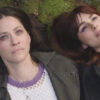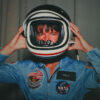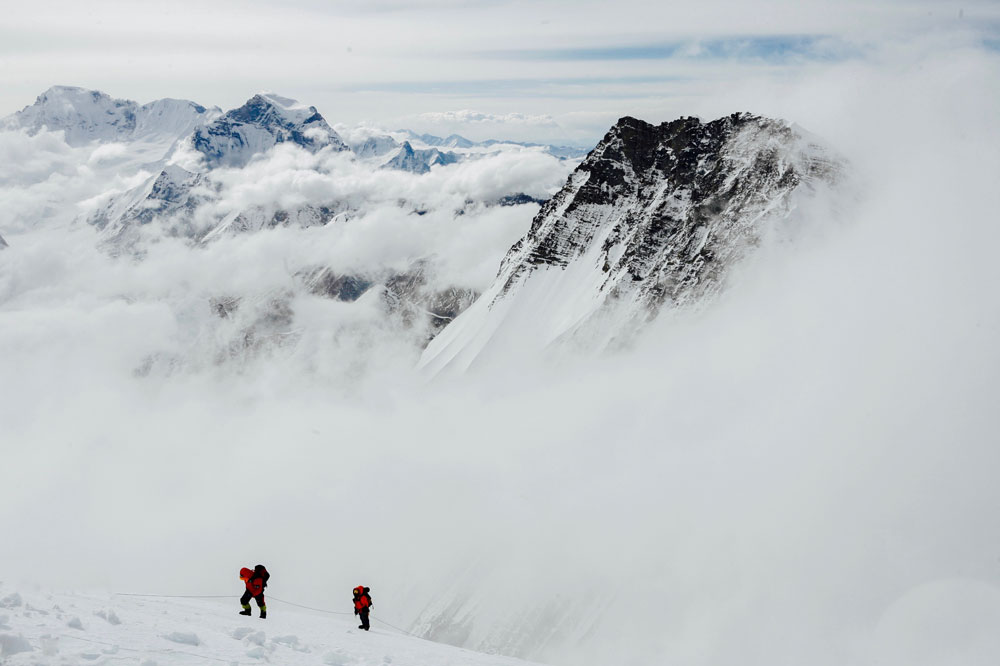In an era when the term is wildly overused, Jennifer Peedom’s “Mountain” is truly awesome, though that’s mainly the point. Having previously scaled the Himalayas in “Sherpa,” the intrepid filmmaker once again teams with the daring cinematographer Renan Ozturk to capture footage from heights that few have ever reached, whether they’re filmmakers or not, inducing gasps with one shot after another of some of the world’s greatest summits. Though it’s implied that someone had to risk their life to capture such shots, the jawdropping sights are meant to convey the majesty of the natural wonders, capable of taking one’s breath away momentarily or permanently, and what’s as impressive as the fact that Peedom allows one access to the imagery is her skepticism of it, not of the authenticity of what’s captured, but of having the ability to in the first place as she comes to question how man has become empowered to tame nature towards our own ends, for better or worse.
“There is an element of wonder and romance and searching for our own identity and this desire to test ourselves in these extreme environments, but there’s also absolutely an element of ego involved and it’s an unusual combination of those two things,” says Peedom, who takes on something every bit as intimidating as scaling any treacherous peak the world has to offer in “Mountain,” asking what is it in our psychology that demands to conquer nature.
Peedom, who made the conscientious decision to tell “Sherpa” from the all-too-rare perspective of the Tibetan guides who put their lives on the line for little in return in facilitating hikes of such summits as Mount Everest, continues to find ways to combat at least a century of blind worship of the men who seek out danger rather than the mountains they’ve climbed, asking not only how one can put aside health concerns to climb mountains clearly not meant to be touched by human hands, but to remake them as playgrounds for the rich to experience things the poor cannot, whether at ski resorts or expeditions that promise priceless adventures that still manage to come at a cost. Featuring narration spoken by Willem Dafoe and penned by Robert McFarlane, an author known for being savvy about how man navigates emotional landscapes when traversing physical ones, “Mountain” earns its moments of triumph in this dazzling collaboration with the Australian Chamber Orchestra by offering a visceral experience that touches the head and the heart equally as it traverses the globe for thrills.
As the film arrives in America, the filmmaker spoke about the unique genesis of the project and the challenges that were part of creating a work of art that could be satisfying as both in movie theaters and in concert halls, in addition to how she was able to present so many extraordinary images.
I was approached by the Australian Chamber Orchestra a number of years ago, just before I went off to the Himalayas to shoot my previous film “Sherpa.” The Orchestra is very well known in Australia for their unusual and very creative collaborations with any number of artists, and they’re known as one of the best chamber orchestras in the world, so it was an enormous privilege to be approached by them. Obviously, I had to go off and make this other film, but while I was shooting “Sherpa” on Mount Everest in 2013, I was with Renan Ozturk, who I also collaborated with on “Mountain,” and we spent a lot of time sitting at base camp on Everest, talking a lot about this film and what it could be and the ideas that it would explore. It was something he was very much wound into from the very beginning and once I finished “Sherpa,” I brought on Robert McFarlane, the wonderful British author of a book that Renan and I had both read called “Mountains of the Mind,” that explored the human fascination with mountains.
Given the gestation of this project, I knew right from the beginning it needed to work as both a live performance for the Australian Chamber Orchestra, [who] did a tour of the film live around the country, but it also had to work as a theatrical, so that original live performance element is very evident in the finished film — it’s the reason that I have the orchestra tuning up at the beginning of the movie. So that was certainly a major factor in the creative point of view for making the film.
What was it like finding the structure for this? Were you putting footage in your backpocket from other shoots or did you figure out a story you wanted to tell and go out and collect footage?
Mainly the former. We had the bulk of the footage already for the film, together with the material that Renan and I had already shot together, and then we really nutted out a structure for the film together with Robert McFarlane. [Renan and I] also shot new material together in the Himalayas and Japan, [where we got] a lot of that powder scene material. But [we collaborated with] Camp4 Collective and Sherpas Cinema, another production company we onboard as co-producers on the film, [because] these guys are the best mountain cinematographers in the world and they opened up their library of incredible material to us.
Renan introduced us to those guys because one of the things that we decided really early on is that we wanted this film to be utterly authentic. We didn’t want to shoot reenactments of climbers doing crazy things, just dropping them on a mountain somewhere and plucking them off after the shot was finished. We really wanted this to be authentic, actual expedition footage, so in order to do that, it would’ve taken years and cost millions of dollars, so we decided to lean on existing footage, given that it was of such incredible quality and often it had been shot for a very short scene and then there were hundreds of hours left.
Then the film started out with this idea that came from Robert’s book to explore the revolution of perception in regards to our feelings towards mountains. Just 300 years ago, we feared and revered mountains. We believed they were the domain of gods and monsters, and now here we are 300 years later, throwing ourselves off them – our relationship has changed dramatically, so [we wanted to] reflect on the meaning of mountains. How do they make us feel? We had that structure in mind, which is a really difficult thing to achieve when you don’t have [specific] interviews and characters, so it was a real process in the edit [figuring out] the shape of it. Once we had a rough cut and looked at where the gaps were in the footage, a little bit more new material was shot and then we reached out to the mountain community – for example, the wing-suit flyers and some of those guys base jumping and we continued to edit from there. It was a stop and start process in many ways.

It was hard actually because you were really fast-forwarding 300 years. We looked at all sorts of old artwork that had dragons on mountains and all these kind of things and at the end, it just didn’t fit it. It felt like black-and-white archival [would], and we just searched for the best of it. We did a lot of footage research and we were able to access that beautiful footage from the BFI and the British Film Institute to find the best of that footage that represented the ideas that we were trying to express, [like] footage from the 1920s British expedition to Mount Everest [with] Mallory and Irving. I remember Robert spent hundreds and hundreds of pages in his book taking us through that period and we raced through it in one sequence, so it’s not a necessarily a blow-by-blow history of those times, but the history itself and [finding] things really did encapsulate those ideas.
In the present-day footage, are there shots in the film that you may have had in mind in a while that either the technology wasn’t there in the past or you uncovered looking through certain collections?
Yeah, the technology [has improved] in the last few years, even since I shot “Sherpa” in 2014, when we were using a lot of GoPros and things like that. In the Himalayas, you certainly couldn’t use drones because there’s not enough oxygen in the air out there. Certainly, that opening shot of [a man] tree climbing, that’s Renan shooting on the rock with him, but then those other wide shots are obviously drone shots and there’s a lot of very high quality Go Pro in the film that really puts you there. Sometimes there are shots where the guy’s looking back down and of course, there’s barely anything there [in terms of seeing camera equipment] and obviously, the wingsuiters and the base jumpers are using that technology, but drone cameras are really changing the game. Everything is lighter and faster and often in my experience, it’s these guys that are doing this really risky, dangerous work in extreme environments who are the ones really pushing the envelope with regards to that technology, demanding that things be lighter and more flexible. And Renan collaborates with a lot of these guys to develop their technology so that it really works for him. He’s somebody who comes from a background of painting who has really embraced technology in order to extend his ability to be a storyteller.

There were a lot of conversations that happened because I had never made a film like this before and they had done a lot of visually experimental type of projects where it very much came from the music first. In this case, we knew [the Australian Chamber Orchestra] had certain requirements that there be some of the larger classical work to satisfy their live touring and their subscription series – you had to think of their audience, so I started out by looking into every piece of classical music they’d ever recorded and then some, trying to figure out what worked. We already had a very rough assembly and ideas of sequences that we then tried to fit that music.
It was incredibly difficult because you can’t cut classical music. That’s what I quickly learned. We weren’t going to be fading out the Beethoven or cutting the Vivaldi. There were certain ethical considerations from the orchestra’s point of view that they weren’t going to mess with that music and also on stage, their audience would know if they cut something. So it was really hard to find pieces of music that expressed those ideas that were also the right length. We had about 50 percent of the film with those preexisting classical works, and then the soundtrack that Richard composed about 50 percent of the score. That was more of a traditional composer/director relationship where we’d talk about the scene and what it was trying to say and some beautiful work came out of that. One of my favorites is what we call the flying sequence where we’re flying, following that wingsuit and there’s a vocalist who happens to be one of the violinists in the orchestra, so she’s just onstage, she walks up to the microphone, holding her violin and starts singing. It was a mixture of both those things, but it was definitely the hardest thing I ever had to do in terms of finding musical solutions to cinematic problems.

It was one of those moments that as a filmmaker you don’t expect to have a film premiere like that, so it was a very, very special moment. It was at the Sydney Opera House, that beautiful building with the white sails that sits on Sydney Harbor and Willem Dafoe came over, which was wonderful for him to be there and the audience was thrilled to see him. There was something about the acoustics in that room that you could hear every breath people were taking and the room was incredibly vocal. I was concerned initially that that would bother the orchestra, but when I spoke to Richard afterwards, he said, “No, I loved it. That’s exactly what we’re trying to do here.” And people were [reacting] like, [gasps] and “Nooooo” [throughout] It was funny and most of the audience just seemed enraptured. They all leapt to their feet at the end of it and seeing it with the orchestra perform like that — they play standing up, and we put the screen right down into the orchestra, so they didn’t have to look up, so it’s a very physical [act] and it was a wonderful, wonderful experience.
“Mountain” opens on May 11th in New York at the Village East Cinemas and May 25th in Los Angeles at the Nuart Theater. A full list of theaters and dates is here.





